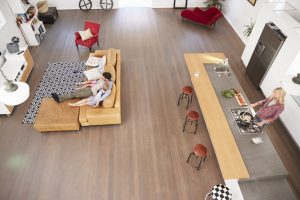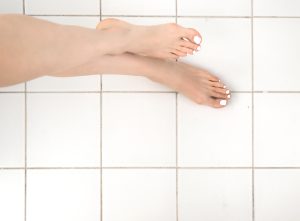Remember when office flooring was an afterthought? Those dreary grey carpets that somehow managed to look worn the day they were installed, or those soul-crushing vinyl tiles that screamed “we gave up on design before we started”? Well, those days are well and truly behind us, thank goodness.
Today’s workplaces are being transformed from the ground up – quite literally – as businesses recognize that the floors beneath our feet play a massive role in everything from employee wellbeing to brand perception. And let me tell you, as someone who’s been in the commercial flooring game for years, it’s about blooming time!
So what’s hot underfoot in the world of modern offices? Let’s dive into the trends that are making waves across workplaces throughout the UK.
Biophilic Flooring: Bringing the Outdoors In
If there’s one trend that’s absolutely exploded post-pandemic, it’s biophilic design – bringing elements of the natural world into our indoor spaces. And it’s not just about dotting a few plants around the place (though that’s lovely too).
Modern offices are now embracing flooring that mimics or complements natural environments:
Wood-look LVT is having an absolute moment right now. These luxury vinyl tiles give you the gorgeous aesthetic of natural timber but with none of the maintenance faff. They’re waterproof, scratch-resistant, and don’t need refinishing every few years – perfect for busy office environments where that gorgeous real wood would take an absolute battering.
Carpet tiles with organic patterns that mimic natural textures like stone, moss, or flowing water are replacing the boring old solid-colour options. Companies like Interface and Milliken are creating stunning collections that look like aerial views of landscapes or abstract interpretations of natural elements.
Actual wood (yes, the real deal) is making a comeback in executive areas and boutique office spaces where the budget stretches a bit further. The difference now is that many companies are opting for sustainable sources and natural finishes that show off the wood’s character rather than masking it under layers of lacquer.
Zoning Without Walls
The open-plan office has had its critics over the years (turns out people don’t love having their every sneeze and snack choice broadcast to 50 colleagues – who knew?). But rather than returning to the cubicle farms of yesteryear, modern offices are using flooring to create subtle but effective zones.
Flooring transitions help delineate spaces without putting up physical barriers. Think carpet in quiet working areas flowing into LVT in collaborative spaces, with perhaps solid wood or polished concrete in breakout zones.
Colour coding helps employees instinctively understand the purpose of different areas. Blue tones might indicate quiet focus areas, while energetic yellows or reds might signal creative collaboration spaces.
Inset designs are being used to create “invisible boundaries” – like a circular carpet inset in a vinyl floor to indicate a meeting area, or directional patterns to subtly guide foot traffic through the space.
One of my favourite recent projects involved using six different flooring materials across one open-plan office, with each transition signalling a shift in work mode without a single wall being built. The result? A flowing, flexible space that still gave employees the environmental cues they needed about appropriate noise levels and activities. Clever stuff.
Sustainability: No Longer Optional
If you’re not considering the environmental impact of your office flooring these days, you’re seriously behind the curve. Sustainability has moved from a “nice to have” to an absolute essential in commercial flooring – not just because it’s the right thing to do, but because employees and clients increasingly demand it.
Carbon-neutral products are leading the charge, with manufacturers like Interface, Forbo, and Tarkett making huge strides in reducing and offsetting the carbon impact of their flooring.
Recycled content is reaching impressive levels, with some carpet tiles now containing up to 80% recycled materials, including reclaimed fishing nets and plastic bottles. Not too shabby, eh?
Circular design principles mean that many modern flooring products are now designed to be recycled at the end of their life, creating a closed-loop system rather than ending up in landfill.
Certification matters more than ever, with savvy office managers looking for FloorScore, Cradle to Cradle, and Global GreenTag certifications to back up environmental claims.
What’s particularly interesting is that many of these sustainable options now perform better than their less eco-friendly predecessors. It’s no longer a case of sacrificing quality or aesthetics for sustainability – you can have your cake and eat it too.
Health-Focused Flooring: The Post-Pandemic Priority
After the events of recent years, it’s hardly surprising that health considerations have moved front and centre in office design. Flooring plays a surprisingly important role in creating healthier workspaces.
Antimicrobial options have seen a massive surge in popularity. Materials treated with antimicrobial technology can reduce the presence of bacteria and certain viruses on surfaces – handy in spaces where lots of people are touching the same surfaces.
Low-VOC products (that’s Volatile Organic Compounds to those not in the know) ensure better indoor air quality by reducing the off-gassing of harmful chemicals. Many manufacturers now offer flooring that meets or exceeds the strictest indoor air quality standards.
Acoustic properties have become a major selling point as we’ve recognized the impact of noise pollution on mental health and productivity. Certain carpet constructions and underlays can reduce noise by up to 30%, making a significant difference in open-plan environments.
Anti-fatigue properties in flooring can reduce the physical strain for employees who stand for long periods. This isn’t just about comfort – it’s about preventing long-term health issues and reducing absenteeism.
Tech-Integrated Flooring: The Next Frontier
If you thought flooring was just something you walk on, think again. Some of the most exciting developments in commercial flooring involve technological integration that would have seemed like science fiction a decade ago.
Raised access flooring has evolved from clunky, utilitarian systems to sleek solutions that allow for easy reconfiguration of power and data access points as office layouts change.
Wireless charging embedded in flooring is beginning to appear in cutting-edge offices, allowing employees to charge devices by simply placing them on specially marked spots on the floor. The future is here, folks!
Smart flooring with sensors that track movement patterns throughout the day is helping companies understand how their office spaces are actually being used, leading to more efficient space planning.
Interactive elements like LED lighting integrated into flooring can create dynamic wayfinding that changes throughout the day based on office needs.
While some of these technologies are still in the early adoption phase, they represent where office flooring is headed – far beyond the merely decorative and into the realm of functional infrastructure that actively contributes to how we work.
Pattern and Colour: Goodbye Boring Beige
Perhaps the most immediately noticeable trend in office flooring is the explosion of pattern and colour. The days of playing it safe with neutral tones that “won’t show the dirt” are behind us, thankfully.
Bold geometrics are everywhere, from triangular carpet tile layouts to hexagonal LVT patterns. These add visual interest while also cleverly disguising the wear patterns that tend to develop in high-traffic areas.
Ombre effects and colour gradients create a sense of flow and movement through spaces, guiding people naturally from one area to another without obvious signage.
Branded colours are being incorporated more subtly and effectively than the “logo carpet” of yesteryear. Think accents of brand colours in collaborative areas or gradient effects that incorporate key brand shades.
Unexpected combinations of materials – like carpet flowing into polished concrete without a transition strip – create striking visual effects that define the modern office aesthetic.
What I find particularly interesting is how these bolder choices actually tend to age better than the supposedly “safe” options of the past. A well-designed patterned floor can hide a multitude of sins over years of use, while that plain beige carpet shows every coffee drip and pen mark.
The Return of Soft Surfaces
After years of hard flooring dominating office design (polished concrete, I’m looking at you), we’re seeing a definite swing back towards softer surfaces – but with a distinctly modern twist.
Plush carpet tiles with higher pile heights are being used in focused work areas and meeting rooms to create a sense of comfort and acoustic privacy.
Blended textures like carpet tiles with varying pile heights create subtle patterns and zoning while maintaining a cohesive look.
Modular rugs that can be reconfigured as office layouts change are providing flexible softness in collaborative areas.
Carpet and hard surface hybrids offer the best of both worlds – the warmth and acoustic benefits of carpet with the durability and easy maintenance of hard surfaces.
This return to softer surfaces reflects a broader trend in office design away from the stark, industrial aesthetic that dominated for years and towards spaces that feel more residential, comfortable, and human-scaled.
Making The Right Choice For Your Office
With so many exciting options available, how do you choose the right flooring for your modern office space? Here are a few pointers to keep in mind:
- Consider your office culture: A creative agency might embrace bold patterns and colour transitions, while a legal firm might prefer a more subtle approach to modern trends.
- Think beyond aesthetics: The most beautiful floor in the world is a poor choice if it doesn’t stand up to your office’s foot traffic or if it creates acoustic issues.
- Plan for the long term: Office design trends evolve, but quality flooring should last 10-15 years. Choose materials and designs with staying power.
- Remember maintenance requirements: That gorgeous white floor might look stunning on day one, but how will it look after three years of tea spills and winter boots?
- Consult the experts: Professional flooring consultants can help navigate the overwhelming range of options and find solutions that balance aesthetics, practicality, and budget.
The Bottom Line
The floors in today’s modern offices are doing so much more than just providing a surface to walk on. They’re defining spaces, reinforcing brand identities, supporting employee wellbeing, contributing to sustainability goals, and even integrating with workplace technology.
The best modern office floors are those that balance visual impact with practical performance – creating spaces that don’t just look good in the Instagram photos on moving day, but continue to perform beautifully for years to come.
Whether you’re planning a complete office overhaul or just refreshing a tired space, considering these trends can help you create a workplace that feels current without falling victim to fads that will look dated before the lease renewal comes around.




